Overview
- Brief Narrative
- Drafting kit used by Mayer Altarac in his stonework/home design business in Belgrade, Yugoslavia (later Serbia) before fleeing with his wife Mimi and seven year old son Jasa in September 1941 following the German occupation in April. They went to Skopje, Macedonia, then under Bulgarian control, as Yugoslavia had been dismembered by the Axis Alliance. A month later, Mayer encountered a man from Kosovo who recognized him as Jewish and the Altarac family fled that night to Pristina, which was under Italian control. There as a large Jewish refugee population there, as the Italians did not regularly deport Jews to the German run concentration camps. In December 1941, the Jewish refugees in Pristina were ordered to move into a transit camp at the main prison. In March 1942, German authorities demanded the deportation of fifty-one Jews to German territory; Jasa's maternal aunt Frida Barta, her husband, and daughter were on the list. The Italians complied and they were all murdered. In September 1943, the Italian military commander informed the Jewish families that Italy had surrendered to the Allies and their troops were withdrawing from Pristina. Assuming the Germans would soon occupy the region, Jasa's family took a taxi to Tirana, Albania. His mother sold hand knit sweaters and one of her customers, Ganimet Toptani, learning that she was Jewish, offered to help them. Her husband, Atif Toptani, took the family to an estate outside of town. In August 1944, a German unit came to search the estate for weapons, as someone had shot at the soldiers. Atif showed them they had no weapons. They were not arrested but they were ordered to move back to Tirana. That September, Tirana was liberated by the partisans. The family returned to Belgrade. In December 1948, the family immigrated to Israel.
- Date
-
received:
1935
- Geography
-
use:
Belgrade (Serbia)
- Credit Line
- United States Holocaust Memorial Museum Collection, Gift of Jas̆a Altarac
- Markings
- c: inside blade, engraved [Richter logo]
d:top, engraved [Richter logo]
e: both legs, outer face, engraved [Richter logo]
i: top, engraved : Richter [logo]
j: top, engraved : Richter [logo]
k: inside blade, engraved [Richter logo]
u: top, engraved : Richter [logo]
w: cap, top, embossed : A1
y: top flap, interior, center, stamped, gold ink : Juszt Ferencz, Latszeresz / Budapest Muzeum – Körut 15
y: top flap, interior, upper right corner, stamped, gold ink : IX.P
y: bottom flap, on snaps, engraved : MADE IN GERMANY
y: top flap, on snaps, engraved : OMPC C-MP-C - Contributor
-
Subject:
Jas̆a Altarac
Previous owner: Jas̆a Altarac
- Biography
-
Jaša Altarac was born on January 1, 1934 in Belgrade, Yugoslavia (Serbia), to Mayer (Meir) and Mimi (Miriam) Finci Altarac. Mimi was born in 1910 in Brcko (now in Bosnia and Hercegovina). Her father was an accountant and she had two brothers, David and Shalom, and a sister, Frida. Shalom immigrated to Palestine before the war. Mayer was born in 1901 in Sarajevo (later in Bosnia and Hercegovina) and had a successful business as a marble craftsman and home contractor. Jaša’s younger sister, Lea Lela, was born in 1937. The family was well off, assimilated, and spoke Serbian. Mayer also supported his mother and other family members in Sarajevo. They traveled by car every year to celebrate Passover with Jaša’s grandmother in Sarajevo.
Yugoslavia was held together by a totalitarian monarchy backed by the military. On April 6, 1941, continuing the policy of eastward expansion, Germany and Italy invaded Yugoslavia supported by Hungary and Bulgaria. Jaša and his family were in Sarajevo for Passover on April 14 and there was an aerial attack. The family rushed to the basement, and the house was directly hit by a bomb. Jaša was thrown through the air. His sister, Lela, was found in the arms of her grandmother, both dead. A few days later, German troops occupied Sarajevo. The family left the city ten days after the funeral for Sabac, a village in central Serbia. They stayed with Miloje Markovic, the foreman of Mayer’s business. On July 18, the family returned to Belgrade. Yugoslavia had been dismembered by the Axis Alliance and Serbia, where Belgrade located, was under German military government. Anti-Jewish policies were immediately implemented. Jews had to register with the police. Jewish men, including Mayer, were taken for forced labor. The Germans took hostages to prevent any resistance, and Jewish hostages were killed for any pretext. Mayer asked a former business partner, and Italian named Erminio Dorio, to help them obtain travel documents for the Italian occupation territory. This area was preferred because Italian authorities generally refused to deport Jews to German-run concentration camps. The permits were not ready as quickly as needed, but Dorio provided a letter on the stationary of the Bulgarian Embassy in Belgrade stating that a travel visa for Skopje was waiting for them in Tirana, Albania.
On September 9, 1941, the family fled to Skopje, Macedonia (now North Macedonia), a former province of Yugoslavia, now occupied by Bulgaria. They rented a room with a Jewish family named Amarillo. On October 10, Mayer met an Albanian man from Kosovo, who recognized Mayer as Jewish. The family left Skopje that night for territory under Italian jurisdiction, and settled in Pristina in Kosovo. Pristina had a large, Jewish refugee population. In December 1941, the Italians ordered the Jewish refugees to move into the main prison. Families remained together, they were allowed to use the prison courtyard, and many of the Italian guards were friendly. Moshe Mandil, a professional photographer from Novi Sad, secured permission for a group of inmates to go to the local market to sell the bread they received from the prison authorities for vegetables and other food. Jewish residents of Pristina also helped the prisoners by providing kosher meals.
On March 17, 1942, German authorities demanded the transfer of the Jews into their custody. The Italians turned over fifty-one individuals. Jaša’s maternal aunt, Frida Barta, her husband, and daughter, Dita, were among them. His mother, Mimi, wanted to join her sister, but an Italian guard convinced her not to go. All fifty-one people were murdered by the Germans. On July 8, the Italian command decided to transfer the Jewish prisoners to Albania. They were divided into groups and each group had to find trucks to take them to different destinations in Albania. Jaša, then eight, and his family went to Kavaje, with four other families: Azriel, Borger, Ruchwarger, and Mandil. There were three other children in the group: Marki Azriel, 14, Gavra Mandil, six, and his sister Beba, five. In Kavaje, the head of each family had to register with the Italian commander daily, but otherwise there were few restrictions. They rented apartments in the same building which they called the Red House. Moshe Mandil opened a photography studio. The children attended a school, with an Italian soldier as their teacher.
In September 1943, the Italian military commander assembled the heads of the Jewish families and announced that Italy had surrendered to the Allies on September 8. The Italian garrison would be leaving town, but they had destroyed the records on the families. The mayor of Kavaje provided documents identifying them citizens and Muslims. It was felt that German forces would soon occupy the town. The Altarac family decided they would be safer in a city and went by taxi with Jasa’s cousin, Sida Levi, and her ten-year-old son, Mikica, to Tirana, the capital. They rented an apartment and Sida and Jaša’s mothers earned money by knitting sweaters. A customer, Ganimet Toptani, who spoke German because her father had been the ambassador to Austria, knew that the family was Jewish and often gave Mimi food for the children. In February 1944, Ganimet asked Mimi to come see her. She told Mimi that the Germans were planning deportation round-ups and that the Jews needed to leave Tirana. Her husband, Atif, moved the Altarac and Levi families to an estate in Kamza, outside Tirana. He later moved Sida and her son to different hiding places. They celebrated Passover with the Mandil family who were being protected by the Veselis family and the Gershons, who were aided by the Frasheris family. In August 1944, the estate was searched by a German unit of Bosnian Muslims, the Hadj Amin El Husseini division (Handjar), after shots were fired at them. They interrogated Mayer, who spoke German, and explained that he was a relative. There were German books, including Nazi propaganda, in the villa, so they believed him and left. Atif moved them to another location in Tirana. In September 1944, Tirana was liberated by partisans.
The Altarac family returned to Belgrade. They later learned that Mimi’s brother David and his family had survived. Shalom had served in the British Army, parachuting behind enemy lines and working with the Yugoslav partisans. In December 1948, the family immigrated to Israel. In 1960, Jaša married Enica Frances, from Skopje, who had survived with her parents, brother, and grandmother in Albania. The couple had two daughters. In 1992, Atif and Ganimet Toptani were recognized as Righteous Among the Nations by Yad Vashem.
Physical Details
- Classification
-
Tools and Equipment
- Category
-
Measuring instruments
- Object Type
-
Drafting equipment (aat)
- Genre/Form
- Equipment.
- Physical Description
- a: Silver-colored metal ruling pen with some corrosion. The pen has a narrow metal shaft with two thin, metal jaws that taper to a point at the end. A metal tightening screw with tic marks and numbers etched into it connects the two jaws. The numbers are arranged clockwise from 0 to 8 in increments of 2.
b: Thin, silver-colored, metal rod with a pronged end. The head is made of two metal pieces fitted together smoothly, creating a rectangular section with a rounded top and bottom with flat sides. The head is hollow and has a circular opening at the front and that is connected to a cutout horizontal line with a circular end on the left and right sides. The top and bottom are connected with a tightening screw on top.
c: Corroded, metal ruling pen tip. It has a short, narrow, cylindrical base with two small prongs on the end. The tip has two thin metal jaws that taper to a point at the end. A metal tightening screw with ridged sides connects the two jaws. The end of the tips is slightly curved down.
d: Metal, drop bow compass with a rusted top. The top of the compass has a small screw with a flat top and ridged sides that, when turned, lowers the screw into the main leg and extends a thin bladed point at the opposite end. The screw extends from a small, cylindrical, ridged handle with a top lip. The main leg is cylindrical and has a rectangular top. The end tapers down to a point that extends out. The second leg is thin and flat and pivots out from the rectangular top of the main leg. The bottom has two small hand screws and a small, rounded, cylindrical attachment on the end to hold a pencil tip. A maker’s mark is engraved on the side of the rectangular top of the main leg.
e: Discolored, metal compass. The top has a small, cylindrical, ridged handle that extends down into two flat pieces screwed to the top of the legs. Both legs are flat and have a small, threaded hole at the center. A threaded rod with an adjustment knob at the center passes through the holes and serves to adjust the width of the legs. They separate from each other by pivoting around a rod between them. Both legs end in a thin, heavily, rusted, pointed blade. These are secured with a tightening screw on the exterior of the leg. The manufacturer's mark is engraved on the exterior of one leg.
f: Small, silver-colored circular disc with a pointed nail sticking out of the bottom center. The top and edges are smooth. Originally attached to “e”.
g: Small, silver-colored circular disc with a pointed nail sticking out of the bottom center. The top is smooth, and the edges are ridged. Originally attached to “e”.
h: Small, thin, cylindrical, silver-colored metal handle with a textured grid pattern design. One end is open with two vertical slits opposite each where an attachment could be added. The opposite end has a grooved end piece that comes unscrewed from the threaded bottom.
i: Metal compass. The top has a small, cylindrical, ridged handle that extends down into two flat pieces screwed into place around the legs. Each side has a small, threaded hole. Both legs are flat with rounded surfaces. They separate from each other by pivoting around the rod in the center of them. The end of one leg has a cylindrical end that holds a small pencil. A small tightening screw is on the interior of the leg. The opposite leg has an attachment with a thin, heavily rusted, pointed blade on the end, attached with a tightening screw on the inside. The manufacturer's name and maker’s mark are engraved on one of the flat pieces below the handle.
j: Metal compass. The top has a small, cylindrical, ridged handle that extends down into two flat pieces screwed into place around the legs. Each side has a small, threaded hole. Both legs are flat with rounded surfaces. They separate from each other by pivoting around the rod in the center of them. The end of one leg has a cylindrical end that holds a small pencil. A small tightening screw is on the interior of the leg. The opposite leg has an attachment with a thin, heavily rusted, pointed blade on the end, attached with a tightening screw on the inside. The manufacturer's name and maker’s mark are engraved on one of the flat pieces below the handle.
k: Corroded, metal ruling pen tip. It has a short, narrow, cylindrical base with two small prongs on the end. The tip has two thin metal jaws that taper to a point at the end. A metal tightening screw with ridged sides connects the two jaws. The end of the tips is slightly curved down.
l: Silver-colored, cylindrical metal tip with an end that tapers down and holds a thin pointed blade that protrudes from the end. The blade is attached with a small metal screw. The opposite end has a small, vertical slot cut into the metal. Three sides of the surface are rounded, while the last side is flat with a central channel.
m-r: Small, flathead, precision screwdriver with a cylindrical, knurled handle (m). The end of the handle is a separate, wider piece with ridged edges (n). It unscrews from the handle, revealing a tubular, interior compartment that holds four small needles. Three are double sided (o-q), and one (r) has a single flattened end. All are corroded. The screwdriver tip is also heavily corroded.
s: Small, silver-colored, cylindrical metal tip with an end that tapers down and holds a thin pointed blade that protrudes from the end. The blade is attached with a small metal screw. The opposite end has a small, vertical slot cut into the metal. Three sides of the surface are rounded, while the last side is flat with a central channel.
t: Very corroded, metal ruling pen tip. It has a short, narrow, cylindrical base with two small prongs on the end. The tip has two thin metal jaws that taper to a point at the end. A metal tightening screw with ridged sides connects the two jaws. The end of the tips is slightly curved down.
u: Silver-colored, metal divider. The top has a small, cylindrical, ridged handle that extends down into two flat pieces screwed into place around the legs. Each side has a small, threaded hole. Both legs are flat, straight and taper to bladed points at the ends. They separate from each other by pivoting around the rod in the center of them. A small tightening screw is on the interior of one leg. The manufacturer's name and maker’s mark are engraved on one of the flat pieces below the handle.
v: Black, metal, ruling pen barrel with a silver-colored, screw-on tip. A horizontal channel is cut into the body just below the rounded rear end. The ridged, silver-colored metal section of the tip screws onto the threaded end of the barrel. The end of the tip has a narrow metal shaft with two thin metal jaws that taper to a point at the end. A metal tightening screw connects the two jaws. The metal tip is heavily rusted.
w: Small, pill-shaped, silver-colored canister with a fitted, removable lid. Around the base is a raised, ridged line that forms the seam when the lid is on the base. The lid is dented around the top.
x: Small, thin, cylindrical, silver-colored metal handle with a textured grid pattern design. One end is open with two vertical slits opposite each where an attachment could be added. The opposite end has a grooved end piece that comes unscrewed from the threaded bottom.
y: Dark brown leather case with a top flap that folds over over the rectangular body and is fastened in place by two black-painted, metal snaps. The front of the case folds down as a bottom flap and two sides fold out as flaps. The interior of the body is lined with dark blue velvet, and there are 17 individualized, fitted slots to hold small tools. Gold text is stamped on the center of the top flap’s interior. There is also a maker’s mark stamped in the lower left corner, and numerals are stamped in the upper right corner. The gold ink is faded in many spots and the leather is worn, particularly on the inner flap and around the edges. Green corrosion is visible around the buttons.
z: Rectangular, brown, cloth pouch with a fold over flap on one end. The snap stud is riveted on the front of the pouch’s body, under the flap. It is visible through a corresponding hole for a snap cap, now missing. The interior of the cloth opposite the button is strengthened with a small, circular patch of leather. The edges of the case are sewn together with brown thread. The cloth is stained throughout. - Dimensions
- overall: Height: 4.500 inches (11.43 cm) | Width: 10.375 inches (26.353 cm)
a: Height: 4.500 inches (11.43 cm) | Width: 0.125 inches (0.318 cm) | Depth: 0.375 inches (0.953 cm)
b: Height: 4.250 inches (10.795 cm) | Width: 0.375 inches (0.953 cm) | Depth: 0.250 inches (0.635 cm)
c: Height: 1.500 inches (3.81 cm) | Width: 0.250 inches (0.635 cm) | Depth: 0.125 inches (0.318 cm)
d: Height: 4.750 inches (12.065 cm) | Width: 0.750 inches (1.905 cm) | Depth: 0.250 inches (0.635 cm)
e: Height: 4.375 inches (11.113 cm) | Width: 0.375 inches (0.953 cm) | Depth: 0.375 inches (0.953 cm)
f: Depth: 0.125 inches (0.318 cm) | Diameter: 0.375 inches (0.953 cm)
g: Depth: 0.125 inches (0.318 cm) | Diameter: 0.250 inches (0.635 cm)
h: Depth: 3.125 inches (7.938 cm) | Diameter: 0.250 inches (0.635 cm)
i: Height: 6.125 inches (15.557 cm) | Width: 0.500 inches (1.27 cm) | Depth: 0.375 inches (0.953 cm)
j: Height: 4.500 inches (11.43 cm) | Width: 0.500 inches (1.27 cm) | Depth: 0.375 inches (0.953 cm)
k: Height: 2.250 inches (5.715 cm) | Width: 0.375 inches (0.953 cm) | Depth: 0.375 inches (0.953 cm)
l: Depth: 2.375 inches (6.032 cm) | Diameter: 0.125 inches (0.318 cm)
m: Height: 2.375 inches (6.032 cm) | Width: 0.250 inches (0.635 cm) | Depth: 0.250 inches (0.635 cm)
n: Depth: 0.250 inches (0.635 cm) | Diameter: 0.250 inches (0.635 cm)
o: Height: 1.250 inches (3.175 cm)
p: Height: 1.250 inches (3.175 cm)
q: Height: 1.250 inches (3.175 cm)
r: Height: 1.250 inches (3.175 cm)
s: Depth: 1.625 inches (4.128 cm) | Diameter: 0.125 inches (0.318 cm)
t: Height: 2.250 inches (5.715 cm) | Width: 0.250 inches (0.635 cm) | Depth: 0.375 inches (0.953 cm)
u: Height: 5.875 inches (14.923 cm) | Width: 0.500 inches (1.27 cm) | Depth: 0.500 inches (1.27 cm)
v: Height: 5.250 inches (13.335 cm) | Width: 0.500 inches (1.27 cm) | Depth: 0.375 inches (0.953 cm)
w: Height: 1.125 inches (2.858 cm) | Width: 0.250 inches (0.635 cm) | Depth: 0.250 inches (0.635 cm)
x: Height: 2.625 inches (6.668 cm) | Width: 0.250 inches (0.635 cm) | Depth: 0.250 inches (0.635 cm)
y: Height: 4.500 inches (11.43 cm) | Width: 10.250 inches (26.035 cm) | Depth: 0.750 inches (1.905 cm)
z: Height: 5.500 inches (13.97 cm) | Width: 11.000 inches (27.94 cm) - Materials
- a : metal
b : metal
c : metal
d : metal, graphite
e : metal
f : metal
g : metal
h : metal
i : metal, graphite
j : metal, graphite
k : metal
l : metal
m : metal
n : metal
o : metal
p : metal
q : metal
r : metal
s : metal
t : metal
u : metal
v : metal
w : metal
x : metal
y : leather, metal, ink, textile
z : textile, metal, leather, thread
Rights & Restrictions
- Conditions on Access
- No restrictions on access
- Conditions on Use
- No restrictions on use
Keywords & Subjects
- Topical Term
- Hidden children (Holocaust)--Albania--Biography. Holocaust, Jewish (1939-1945)--Yugoslavia--Personal narratives. Jewish children in the Holocaust--Yugoslavia--Biography. Jewish refugees--Albania--Biography. Jews--Serbia--Belgrade--Biography. Righteous Gentiles in the Holocaust--Albania--Personal narratives. World War, 1939-1945--Refugees--Albania--Personal narratives. World War, 1939-1945--Jews--Rescue--Albania--Personal narratives. Yugoslavia--History--Axis occupation, 1941-1945.
Administrative Notes
- Legal Status
- Permanent Collection
- Provenance
- The drafting kit was donated to the United States Holocaust Memorial Museum in 2002 by Jas̆a Altarac, the son of Mayer Altarac.
- Record last modified:
- 2024-07-24 14:12:22
- This page:
- https://collections.ushmm.org/search/catalog/irn520799
Download & Licensing
In-Person Research
- By Appointment
- Request 21 Days in Advance of Visit
- Plan a Research Visit
- Request to See This Object
Contact Us
Also in Jaša and Enica Frances Altarac families collection
The collection consists of artifacts, documents, and photographs relating to the experiences of Jaša Altarac and his family before and during the war in Belgrade, Yugoslavia (later Serbia,) and during the Holocaust in Skopje, Macedonia, Pristina, Kosovo, and Albania and two photographs relating to the experiences of Enica Frances and her family in Albania during the Holocaust.
Date: approximately 1915-approximately 1964
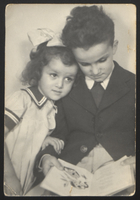
Jas̆a Altarac papers
Document
The Jaša Altarac papers consist of biographical materials, correspondence, Mermer-Oniks business records, photographic materials, and a newspaper documenting the Altarac family in Belgrade; their Holocaust itinerary of flight, imprisonment, deportation, and hiding through Skopje, Pristina, Kavaja, Kamza, and Tirana; and Mayer Altarac’s marble business Mermer-Oniks. Biographical materials include identification papers, travel permissions, labor documents, and false identification papers documenting Mayer, Mimi, and Jaša Altarac in Belgrade, Skopje, Pristina, Kavaja, and Tirana. This series also includes the notebook the Altarac family used to record the signatures of Italian police in Kavaja proving that the family reported to the police station daily. Correspondence includes Red Cross inquiries from Mimi Altarac seeking information about Frieda and Andrija Barta and about Esther, Ana, and Leon Finci as well as two letters from Albert Altarac, Mayer Altarac's brother, to Gavro Navon and Mario Altarac in Pristina. This series also includes postwar receipts for money sent to Palomba Finci, Hajima Altarac, and Joska Herman in Vareš-Majdan, Mostar, and Sarajevo. Mermer-Oniks records include prewar building documents, commercial correspondence, letterhead, and tax payments as well as postwar surveys of quarries documenting Mayer Altarac’s marble and granite business. Mayer was one of the most prominent architects in prewar Belgrade. He discovered several sources of marble and other stone in Yugoslavia and used the stone from his quarries in his architectural projects. Photographic materials include loose family photographs and pages from a family photo album documenting the Altarac family in Belgrade, Sarajevo, Pristina, Kavaja, Kamza, and Tirana, as well as vacation photos from Bled, Makarska, Planica, Postojna, and Split. Photographs include the Altarac family while imprisoned in Pristina and while living at the “red house” in Kavaja, Jasa Altarac’s class portrait from Kavaja where he attended school under a false Muslim identify, and photographs of the family during hiding in Kamza and Tirana. This series also includes two photographs of Jaša Altarac’s wife, Enica Frances, and her family from Skopje. They were rescued during the war by Dr. Tode and Lala Hadjimitkov, taken to Tirana, and went into hiding. Albanians Zonda and Hamdi Kasapi later helped them escape arrest and hid them in the remote village of Zaliheri. The newspaper is the May 9, 1945 issue of Borba, the Yugoslav communist party organ.
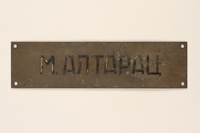
Nameplate from the home of the Altarac family who fled from German occupying forces
Object
Nameplate that originally hung on the outside of seven-year-old Jas̆a Altarac's family home in Belgrade, Yugoslavia (later Serbia), before he and his parents, Mayer and Mimi, fled to Skopje, Macedonia, in September 1941, following the German invasion in April. Yugoslavia had been dismembered by the Axis Alliance, and Skopje was now controlled by Bulgaria. A month later, Mayer encountered a man from Kosovo who recognized him as Jewish and the Altarac family fled that night to Pristina, which was under Italian control. There as a large Jewish refugee population there, as the Italians did not regularly deport Jews to the German-run concentration camps. In December 1941, the Jewish refugees in Pristina were ordered to move into a transit camp at the main prison. In March 1942, German authorities demanded the deportation of fifty-one Jews to German territory. This group included Jas̆a 's maternal aunt Frida Barta, her husband, and daughter. The Italians complied and they were all murdered. In September 1943, the Italian military commander informed the Jewish families that Italy had surrendered to the Allies and their troops were withdrawing from Pristina. Assuming the Germans would soon occupy the region, Jas̆a 's family took a taxi to Tirana, Albania. His mother sold hand knit sweaters, and one of her customers, Ganimet Toptani, learning that she was Jewish, offered to help them. Her husband, Atif Toptani, took the family to an estate outside of town. In August 1944, a German unit came to search the estate for weapons, as someone had shot at the soldiers. Atif showed them they had no weapons. They were not arrested, but they were ordered to move back to Tirana. That September, Tirana was liberated by the partisans. The family returned to Belgrade. In December 1948, the family immigrated to Israel.
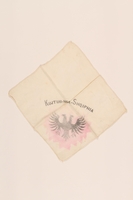
Handkerchief bearing a two-headed eagle owned by the Altarac family who fled from German occupying forces
Object
White handkerchief emblazoned with a two-headed eagle, the symbol of Albania, owned by Jas̆a Altarac. Seven-year-old Jas̆a and his parents, Mayer and Mimi, fled Belgrade, Yugoslavia (later Serbia), for Skopje, Macedonia, in September 1941, following the German invasion in April. Yugoslavia had been dismembered by the Axis Alliance, and Skopje was now controlled by Bulgaria. A month later, Mayer encountered a man from Kosovo who recognized him as Jewish and the Altarac family fled that night to Pristina, which was under Italian control. There as a large Jewish refugee population there, as the Italians did not regularly deport Jews to the German-run concentration camps. In December 1941, the Jewish refugees in Pristina were ordered to move into a transit camp at the main prison. In March 1942, German authorities demanded the deportation of fifty-one Jews to German territory. This group included Jas̆a 's maternal aunt Frida Barta, her husband, and daughter. The Italians complied and they were all murdered. In September 1943, the Italian military commander informed the Jewish families that Italy had surrendered to the Allies and their troops were withdrawing from Pristina. Assuming the Germans would soon occupy the region, Jas̆a 's family took a taxi to Tirana, Albania. His mother sold hand knit sweaters, and one of her customers, Ganimet Toptani, learning that she was Jewish, offered to help them. Her husband, Atif Toptani, took the family to an estate outside of town. In August 1944, a German unit came to search the estate for weapons, as someone had shot at the soldiers. Atif showed them they had no weapons. They were not arrested, but they were ordered to move back to Tirana. That September, Tirana was liberated by the partisans. The family returned to Belgrade. In December 1948, the family immigrated to Israel.
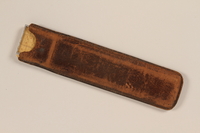
Slide rule used by Mayer Altarac whose family fled from German occupying forces
Object
Slide rule used by Mayer Altarac in his stonework and home design business in Belgrade, Yugoslavia (later Serbia). In September 1941, he fled with his wife, Mimi, and seven-year-old son, Jas̆a, following the German occupation in April. They went to Skopje, Macedonia, then under Bulgarian control because Yugoslavia had been dismembered by the Axis Alliance. A month later, Mayer encountered a man from Kosovo who recognized him as Jewish and the Altarac family fled that night to Pristina, which was under Italian control. There as a large Jewish refugee population there, as the Italians did not regularly deport Jews to the German-run concentration camps. In December 1941, the Jewish refugees in Pristina were ordered to move into a transit camp at the main prison. In March 1942, German authorities demanded the deportation of fifty-one Jews to German territory. This group included Jas̆a 's maternal aunt Frida Barta, her husband, and daughter. The Italians complied and they were all murdered. In September 1943, the Italian military commander informed the Jewish families that Italy had surrendered to the Allies and their troops were withdrawing from Pristina. Assuming the Germans would soon occupy the region, Jas̆a 's family took a taxi to Tirana, Albania. His mother sold hand knit sweaters, and one of her customers, Ganimet Toptani, learning that she was Jewish, offered to help them. Her husband, Atif Toptani, took the family to an estate outside of town. In August 1944, a German unit came to search the estate for weapons, as someone had shot at the soldiers. Atif showed them they had no weapons. They were not arrested, but they were ordered to move back to Tirana. That September, Tirana was liberated by the partisans. The family returned to Belgrade. In December 1948, the family immigrated to Israel.
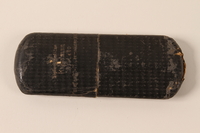
Eyeglasses and case used Mayer Altarac whose family fled from German occupying forces
Object
Eyeglasses and case used by Mayer Altarac, who owned a stonework and construction business in Belgrade, Yugoslavia (later Serbia). In September 1941, he fled with his wife, Mimi, and seven-year-old son, Jas̆a, following the German occupation in April. They went to Skopje, Macedonia, which was under Bulgarian control because Yugoslavia had been dismembered by the Axis Alliance. A month later, Mayer encountered a man from Kosovo who recognized him as Jewish and the Altarac family fled that night to Pristina, which was under Italian control. There as a large Jewish refugee population there, as the Italians did not regularly deport Jews to the German-run concentration camps. In December 1941, the Jewish refugees in Pristina were ordered to move into a transit camp at the main prison. In March 1942, German authorities demanded the deportation of fifty-one Jews to German territory. This group included Jas̆a 's maternal aunt Frida Barta, her husband, and daughter. The Italians complied and they were all murdered. In September 1943, the Italian military commander informed the Jewish families that Italy had surrendered to the Allies and their troops were withdrawing from Pristina. Assuming the Germans would soon occupy the region, Jas̆a 's family took a taxi to Tirana, Albania. His mother sold hand knit sweaters, and one of her customers, Ganimet Toptani, learning that she was Jewish, offered to help them. Her husband, Atif Toptani, took the family to an estate outside of town. In August 1944, a German unit came to search the estate for weapons, as someone had shot at the soldiers. Atif showed them they had no weapons. They were not arrested, but they were ordered to move back to Tirana. That September, Tirana was liberated by the partisans. The family returned to Belgrade. In December 1948, the family immigrated to Israel.
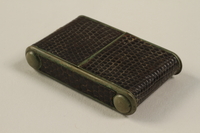
Travel clock within a brown leather case used by the Altarac family while imprisoned
Object
Travel clock used by all the Jewish occupants of the "red house" in Kavajë, Albania, where the Altarac family was interned for several months. This was the only working clock. In September 1941, seven-year-old Jas̆a and his parents, Mayer and Mimi, fled Belgrade, Yugoslavia (later Serbia), for Skopje, Macedonia, following the German invasion in April. Yugoslavia had been dismembered by the Axis Alliance, and Skopje was now controlled by Bulgaria. A month later, Mayer encountered a man from Kosovo who recognized him as Jewish and the Altarac family fled that night to Pristina, which was under Italian control. There as a large Jewish refugee population there, as the Italians did not regularly deport Jews to the German-run concentration camps. In December 1941, the Jewish refugees in Pristina were ordered to move into a transit camp at the main prison. In March 1942, German authorities demanded the deportation of fifty-one Jews to German territory. This group included Jas̆a 's maternal aunt Frida Barta, her husband, and daughter. The Italians complied and they were all murdered. In September 1943, the Italian military commander informed the Jewish families that Italy had surrendered to the Allies and their troops were withdrawing from Pristina. Assuming the Germans would soon occupy the region, Jas̆a 's family took a taxi to Tirana, Albania. His mother sold hand knit sweaters, and one of her customers, Ganimet Toptani, learning that she was Jewish, offered to help them. Her husband, Atif Toptani, took the family to an estate outside of town. In August 1944, a German unit came to search the estate for weapons, as someone had shot at the soldiers. Atif showed them they had no weapons. They were not arrested, but they were ordered to move back to Tirana. That September, Tirana was liberated by the partisans. The family returned to Belgrade. In December 1948, the family immigrated to Israel.
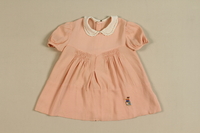
Embroidered, pink dress once worn by Lela Altarac, who was killed in a bombing raid
Object
Pink dress with embroidery worn by four-year-old Lela Altarac, who was killed on April 14, 1941, in a German bombing raid on Sarajevo, Yugoslavia (later Bosnia and Hercegovina.) In September 1941, seven-year-old Jas̆a and his parents, Mayer and Mimi, fled Belgrade, Yugoslavia (later Serbia), for Skopje, Macedonia, following the German invasion in April. Yugoslavia had been dismembered by the Axis Alliance, and Skopje was now controlled by Bulgaria. A month later, Mayer encountered a man from Kosovo who recognized him as Jewish and the Altarac family fled that night to Pristina, which was under Italian control. There as a large Jewish refugee population there, as the Italians did not regularly deport Jews to the German-run concentration camps. In December 1941, the Jewish refugees in Pristina were ordered to move into a transit camp at the main prison. In March 1942, German authorities demanded the deportation of fifty-one Jews to German territory. This group included Jas̆a 's maternal aunt Frida Barta, her husband, and daughter. The Italians complied and they were all murdered. In September 1943, the Italian military commander informed the Jewish families that Italy had surrendered to the Allies and their troops were withdrawing from Pristina. Assuming the Germans would soon occupy the region, Jas̆a 's family took a taxi to Tirana, Albania. His mother sold hand knit sweaters, and one of her customers, Ganimet Toptani, learning that she was Jewish, offered to help them. Her husband, Atif Toptani, took the family to an estate outside of town. In August 1944, a German unit came to search the estate for weapons, as someone had shot at the soldiers. Atif showed them they had no weapons. They were not arrested, but they were ordered to move back to Tirana. That September, Tirana was liberated by the partisans. The family returned to Belgrade. In December 1948, the family immigrated to Israel.
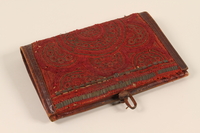
Purse carried by Mimi Altarac who fled German-occupied Belgrade with her family
Object
Purse used by Mimi Altarac to hold all the family documents during World War II (1939-1945). In September 1941, seven-year-old Jas̆a and his parents, Mayer and Mimi, fled Belgrade, Yugoslavia (later Serbia), for Skopje, Macedonia, following the German invasion in April. Yugoslavia had been dismembered by the Axis Alliance, and Skopje was now controlled by Bulgaria. A month later, Mayer encountered a man from Kosovo who recognized him as Jewish and the Altarac family fled that night to Pristina, which was under Italian control. There as a large Jewish refugee population there, as the Italians did not regularly deport Jews to the German-run concentration camps. In December 1941, the Jewish refugees in Pristina were ordered to move into a transit camp at the main prison. In March 1942, German authorities demanded the deportation of fifty-one Jews to German territory. This group included Jas̆a 's maternal aunt Frida Barta, her husband, and daughter. The Italians complied and they were all murdered. In September 1943, the Italian military commander informed the Jewish families that Italy had surrendered to the Allies and their troops were withdrawing from Pristina. Assuming the Germans would soon occupy the region, Jas̆a 's family took a taxi to Tirana, Albania. His mother sold hand knit sweaters, and one of her customers, Ganimet Toptani, learning that she was Jewish, offered to help them. Her husband, Atif Toptani, took the family to an estate outside of town. In August 1944, a German unit came to search the estate for weapons, as someone had shot at the soldiers. Atif showed them they had no weapons. They were not arrested, but they were ordered to move back to Tirana. That September, Tirana was liberated by the partisans. The family returned to Belgrade. In December 1948, the family immigrated to Israel.
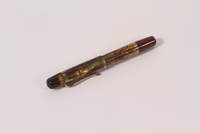
Pelikan fountain pen used by Mayer Altarac who fled German-occupied Belgrade with his family
Object
Fountain pen used by Mayer Altarac in his stonework and home design business in Belgrade, Yugoslavia (later Serbia). In September 1941, he fled with his wife, Mimi, and seven-year-old son, Jas̆a, following the German occupation in April. Yugoslavia had been dismembered by the Axis Alliance, and Skopje was now controlled by Bulgaria. A month later, Mayer encountered a man from Kosovo who recognized him as Jewish and the Altarac family fled that night to Pristina, which was under Italian control. There as a large Jewish refugee population there, as the Italians did not regularly deport Jews to the German-run concentration camps. In December 1941, the Jewish refugees in Pristina were ordered to move into a transit camp at the main prison. In March 1942, German authorities demanded the deportation of fifty-one Jews to German territory. This group included Jas̆a 's maternal aunt Frida Barta, her husband, and daughter. The Italians complied and they were all murdered. In September 1943, the Italian military commander informed the Jewish families that Italy had surrendered to the Allies and their troops were withdrawing from Pristina. Assuming the Germans would soon occupy the region, Jas̆a 's family took a taxi to Tirana, Albania. His mother sold hand knit sweaters, and one of her customers, Ganimet Toptani, learning that she was Jewish, offered to help them. Her husband, Atif Toptani, took the family to an estate outside of town. In August 1944, a German unit came to search the estate for weapons, as someone had shot at the soldiers. Atif showed them they had no weapons. They were not arrested, but they were ordered to move back to Tirana. That September, Tirana was liberated by the partisans. The family returned to Belgrade. In December 1948, the family immigrated to Israel.
Drafting tool piece used by Mayer Altarac who fled German-occupied Belgrade with his family
Object
Drafting tool piece used by Mayer Altarac in his stonework and home design business in Belgrade, Yugoslavia (later Serbia). In September 1941, he fled with his wife, Mimi, and seven-year-old son Jas̆a, following the German occupation in April. They went to Skopje, Macedonia, then under Bulgarian control because Yugoslavia had been dismembered by the Axis Alliance. A month later, Mayer encountered a man from Kosovo who recognized him as Jewish and the Altarac family fled that night to Pristina, which was under Italian control. There as a large Jewish refugee population there, as the Italians did not regularly deport Jews to the German-run concentration camps. In December 1941, the Jewish refugees in Pristina were ordered to move into a transit camp at the main prison. In March 1942, German authorities demanded the deportation of fifty-one Jews to German territory. This group included Jas̆a 's maternal aunt Frida Barta, her husband, and daughter. The Italians complied and they were all murdered. In September 1943, the Italian military commander informed the Jewish families that Italy had surrendered to the Allies and their troops were withdrawing from Pristina. Assuming the Germans would soon occupy the region, Jas̆a 's family took a taxi to Tirana, Albania. His mother sold hand knit sweaters, and one of her customers, Ganimet Toptani, learning that she was Jewish, offered to help them. Her husband, Atif Toptani, took the family to an estate outside of town. In August 1944, a German unit came to search the estate for weapons, as someone had shot at the soldiers. Atif showed them they had no weapons. They were not arrested, but they were ordered to move back to Tirana. That September, Tirana was liberated by the partisans. The family returned to Belgrade. In December 1948, the family immigrated to Israel.



